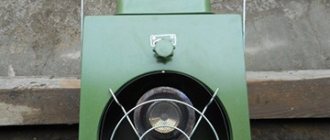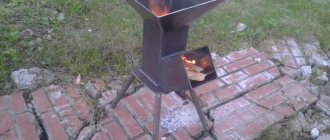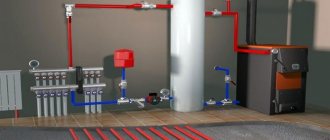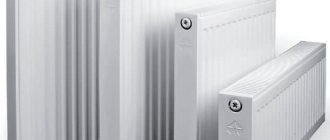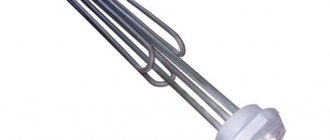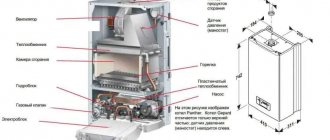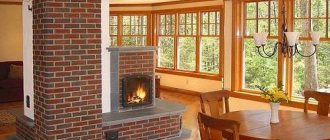Owners of suburban areas almost always build bathhouses. This is a traditional building for Russian people, where they perform water procedures, invigorate and heal the body. It usually contains a sauna stove with a water tank. Let's consider the features of this design, the principle of its operation, and the requirements for it. We will also tell you about the existing types of stoves, depending on the materials used and the location of the tanks, as well as about the popular version of the water heating system.
Sauna stove with water tank Source ateliesaun.ru
Design features
A sauna stove with a water tank provides heat to the building. Bricks or ferrous metal are used to make it. It maintains the required temperature, including the heat in the steam room. This design includes the following main parts:
- The firebox is designed for burning fuel. This is where heat is released.
- A heater used to conserve thermal energy by heating stones due to the combustion of wood in a firebox.
- Grate, which is made of cast iron. Its installation can be done in different positions. The placement of the grill depends on the type of fuel used. When a sauna stove with a water tank and a heater is designed to burn wood, then the grate is installed at the same level as the door.
- Ash pan located under the fuel compartment. It is used to accumulate ash. Its removal is done manually.
- A tunnel with a door designed for heating the stove from the dressing room.
- A heat exchanger used to transfer thermal energy to water.
- A smoke exhaust duct, which is a pipe. She comes out of the firebox.
Design of a stove with a tank Source oboiman.ru
Gas generator installation
Install the units closer to the wall, since the outlet pipe for the chimney is usually located at the rear. Industrial boilers have legs that can be adjusted in height. This greatly simplifies the process of connecting the boiler to the chimney.
Particular care should be taken when installing long-burning solid fuel stoves with a water circuit in country wooden houses. The wall where the gas generator will stand must be covered with fire-resistant material.
The big advantage of such units is that they can be connected to an existing water heating system, which runs on electric or gas appliances. A wood-burning stove with a water circuit will be an excellent backup heat source if necessary.
Nowadays you can buy heating boilers that look like a regular fireplace in design. However, the operating principle is the same as that of gas generating units with heat exchangers. Thus, they can also act as a beautiful piece of furniture.
Operating principle
Almost any sauna stove with a water tank works on the same principle. First, the firewood is placed in the firebox. Then the fuel is lit. After this, the hot air begins to rise and pass through the heater. As a result, the stones heat up. They become very hot and gradually give off heat. Therefore, the steam room maintains a high temperature for a long time.
Depending on the models, it is often necessary to periodically add firewood to the stoves during operation. After all, this type of fuel is characterized by rapid combustion. Its addition to the firebox allows you to maintain a comfortable temperature in the room for a longer time.
It is recommended to use birch firewood or alder logs as fuel. A stove in a bathhouse with a tank can also be heated using coal or peat briquettes. In any case, dry fuel must be used. In this state, it will allow you to quickly heat the bath rooms. It is not recommended to use coniferous firewood because it produces a large amount of soot. As a result, the smoke exhaust duct will become more quickly contaminated.
Birch firewood for a sauna stove Source stiproduction-a.akamaihd.net
Manufacturers produce long-burning models. These stoves do not require adding wood for 6-20 hours. This makes it easier to control the room temperature. Such furnace devices differ in the combustion process. It happens from top to bottom.
Homemade gas generator units
Homemade versions of gas generators, made taking into account all the rules, also have the right to life, along with industrial models. The main requirement for such boilers is the installation of two combustion chambers.
Often, home craftsmen use an ordinary metal barrel of the appropriate size as the body of a homemade long-burning stove with a water circuit. You can weld it yourself from a durable metal sheet.
A steel pipe is attached to the body. The chamber is divided by a grate. A heat exchanger is installed to connect to the water circuit. It is advisable to paint the body with a fire-resistant paint solution.
Types of sauna stoves by material
A modern bathhouse stove with a water tank can have a brick or all-metal structure. In the manufacture of the first version of the device, steel and cast iron are usually used. Manufacturers produce metal stoves in different designs. There are a huge number of such models on the market.
Metal stoves can have a square, cylindrical, rectangular shape. Any such device is quite easy to install. There is no need to build a foundation during its installation. A metal stove can heat a room in a short period of time. At the same time, this design cools quickly and has poor resistance to sudden temperature changes.
Metal sauna stove Source prom.st
Brick sauna stoves have a longer service life. They are able to retain thermal energy longer and have an attractive appearance. However, for their construction it is first necessary to build a foundation. Therefore, creating brick devices requires more time and physical effort than installing metal furnace structures.
See also: Catalog of companies that specialize in the design and installation of fireplaces and stoves
Types of stoves according to the location of water containers
Bathhouse owners have the opportunity to choose a stove with a different location of the water tank. A professional in this field will always help you choose the best option. Therefore, if you need to equip a building with such a device, it is better to immediately contact a specialized company.
Remote water tanks
This variety is one of the best designs. After all, such a tank for water in a bathhouse is usually located outside the steam room. In this case, the oven is located in the steam room. Therefore, it heats not only the steam room and water, but also the neighboring room. At the same time, the humidity in the steam room does not increase as long as there is cold water in the container.
Remote tank in the next room with a steam room Source fgssm.ru
Typically, stainless steel is used to make this type of tank. More often, a remote tank for hot water in a bathhouse is installed in an adjacent room with a steam room. To heat water from the furnace structure, a register is additionally installed. In this case, the connection of all elements of the system is carried out by laying pipelines.
The register and the tank are connected using pipes that can withstand high temperatures. It is recommended to lay copper or stainless steel pipelines at least 500 mm from the furnace structure. If they are connected to metal-plastic pipes, then special fittings are used.
A remote water tank in the bathhouse is installed subject to certain rules:
- the lower level of the tank must be at least 500 mm above the register;
- the length of pipelines should be a maximum of 3000 mm;
- pipes must be installed without sagging;
- the diameter of the pipelines must be at least 25 mm;
- Pipe installation should be carried out with a slope of 2° to 5°.
Design of a system with a remote tank, heat exchanger and stove-stove Source oboiman.ru
Water is poured into a cold system. If you do the opposite, then there is a high probability that the register will break due to a sudden change in temperature.
Equipping the bathhouse with a remote water tank allows you to equip the building with a separate shower. You can also organize a Finnish sauna in the building or connect a radiator to heat, for example, a locker room during the cold season.
Installation of such a system is accompanied by certain difficulties. However, its arrangement is not cheap. After all, you need to purchase pipelines, a register, a container, a tap for a hot water tank in the bathhouse and the stove itself. In addition, you will need to pay for the work of professionals who will install the entire system.
Built-in water tanks
This type of tank is usually mounted above the firebox. Such a tank for hot water in a bath can also be placed on either side of the stove. However, the containers differ in shape. However, the most popular is the rectangular tank.
Metal sauna stove with built-in water tank Source prostopechi.ru
Built-in containers are often made of stainless steel. Typically the metal thickness is from 0.8 to 1.5 mm. The design has a hole for filling water, and to drain it, a ball valve is installed in the lower part.
The built-in container is inconvenient to use due to the fact that it cannot be left empty when the stove is in use. At the same time, a constantly filled tank causes a regular increase in humidity in bath rooms. Therefore, they do not always have time to dry. In addition, you constantly have to monitor the water level and periodically replenish the volume of the bath tank.
Heat exchanger connection diagrams
Within the framework of this publication, we will not describe methods for making stoves, but will immediately move on to the binding. If you want to make a water heating stove yourself, we recommend that you read the separate manuals:
- homemade heater for the garage using solid fuel and waste;
- instructions for fireplace and stove laying;
- diagram and order of a hob with a water boiler.
If you purchased a factory-made stove with a heat exchanger, carefully study the attached instructions. The documentation always indicates the diameters of the pipes and methods of connecting the water circuit to heating devices. Usually 2 schemes are used:
- An open system with gravitational (convective) coolant flow.
- Closed radiator network with forced movement of water from a pump.
It is not necessary to use a circulation pump in this scheme, but the forced movement of water noticeably speeds up heating
Note. In gravity circuits, circulation pumps installed on the bypass are often used. The goal is to reduce the temperature difference between supply and return, increasing the coolant speed and heating efficiency. In the absence of electricity, the system will continue to operate in gravity mode.
Gravity flow is organized by increasing the diameters of highways and the slopes of horizontal sections. The minimum cross-section of the distribution manifold with a gravity scheme is 32 mm (inch and a quarter), the slope is 3...5 mm per 1 linear meter. The open expansion tank is at the top point, where all the air entering the system goes.
The safety group on the feed is not shown, but it must be present
With the closed circuit shown in the figure above, the coolant is under pressure (at least 1 bar “cold”) and moves under the pressure of the pump. The membrane expansion tank is located at the lowest point and is connected to the return line through a shut-off valve. It is mandatory to install a safety group with an air vent, pressure gauge and relief valve.
Advice on choosing a scheme. When buying a stove for a home with water heating, the homeowner obviously expects the system to operate autonomously. Hence the conclusion: for joint work with a hot-water furnace, a gravity-flow scheme is best suited. After turning off the light, circulation in the circuit will not stop and the heat exchanger will not burn out.
An example of a gravity circuit powered by a brick stationary stove
Video description
One of the furnace options with a hanging tank is described in the video:
Attached water tanks
This type of tank is an original option. However, it is not often used in baths. The design contains a pipe, which is placed at an angle from the bottom of the container to the furnace. In this case, the tank is mounted above the furnace device.
During heating, the water first pours and boils in a pipe that is inclined. As a result, bubbles form. They travel down an inclined pipe into cold water and burst. Thanks to this circulation, heat transfer occurs.
Water tanks for chimneys
Tanks installed on smoke exhaust ducts are a popular type of tank for heating water. Its temperature rises due to hot air passing through the pipe. The smoke channel is located in the center of the tank.
The tank for heating water in the bathhouse on the chimney can have different designs. Manufacturers make such containers in triangular, oval, square, round and other shapes. This allows you to select a tank for a specific stove, chimney configuration and building.
Sauna stove with a tank on a pipe Source kraski-net.ru
By using a tank on the chimney, heat does not escape into the chimney. In addition, the temperature of the smoke exhaust duct decreases. Therefore, its service life increases. This type of tank also allows you to save usable space in the steam room and throughout the bathhouse.
One of the disadvantages of tanks on chimneys is the inconvenience of filling them with water. After all, the hole for it will be located higher than most other similar containers. The exception is tanks that are mounted immediately above the stove. In a pipe-based design, it is still difficult to control the water level and its temperature.
In addition, a sauna heater stove with a water tank on the chimney is equipped with additional fasteners. They are needed to securely place the container. After all, its weight with water can be, for example, 100 kg. This drawback complicates the installation of the tank on the smoke exhaust duct.
Laying out the oven from bricks
If you have some practical experience in building brick stoves, try building a large sauna stove with your own hands. We offer a stove-heater option with dimensions of 102 x 129 cm, equipped with a 170-liter tank and designed to heat a bathhouse with an area of 12 m².
To build the stove shown in the drawing, prepare a set of materials:
- solid clay brick (red) – 580 pcs.;
- fireclay stone grade ША-8 – 80 pcs.;
- cast iron grates measuring 30 x 25 cm - 2 grates;
- main door for loading firewood – 210 x 250 mm;
- ash chamber door – 14 x 25 cm;
- smoke damper – 320 x 450 mm;
- heater door – 51 x 42 cm;
- steel pipe with a diameter of 57 x 4 mm - 6.3 m;
- iron strip with a cross section of 40 x 5 mm - 2 m;
- the same, size 80 x 10 mm - 2.5 m;
- basalt cardboard, roofing felt.
Note. The list did not include the brick required for the construction of the chimney, cement, clay and sand for mixing the mortar.
Also, before construction, you need to weld a tank-boiler with dimensions of 102 x 77 x 25 cm from sheet steel grade St20 with a thickness of at least 3 mm. We will not outline the technology for installing a reinforced concrete foundation, preparing mortar and stove masonry - it is described in detail in the instructions for constructing a fireplace.
Let's move on to building the furnace according to the presented procedures:
- The zero and first rows are laid in a continuous line. Tiers 2 and 3 form an ash pit, and a blower door is installed.
- Row No. 4, covering the door, is the bottom of the fuel chamber, partially lined with fire-resistant stones with a gap of 5 mm from red bricks. Trimming is done, a grate and a loading door are inserted.
- When laying tiers 5-9, the walls of the firebox are built. On the 10th row, cells are prepared for pipes, cut into pieces 1050 mm long. These parts are placed in nests and sealed with basalt cardboard, and a water container is installed.
- From the 11th to the 20th tier, the furnace walls are built around the tank. On the 20th row, the end of the boiler is covered with two steel strips L = 35 cm.
- The heater door is installed on the 21st row, and the laying of the outer walls continues according to the scheme up to the 26th tier. On top of the door we place 2 strips 650 mm long.
- On the 27th row, the stove overlap begins to form. Cutouts are made for laying large strips 120 cm long. Bricks of the 28th tier cover the cavity of the heater, leaving a chimney opening.
- The flue valve is installed on the 28th row, tiers 29-32 finally form the stove vault and the transition to the chimney.
Six jumpers in the form of Ø57 mm pipes serve as supports for the future array of stones and at the same time serve as convective air heaters in the sauna. After 2-3 days, when the solution has dried thoroughly, you need to eliminate the defects, load the heater and begin test lighting. For a detailed description of the masonry in rows, see the next video:
Video description
The containers for chimneys from sauna stoves are described in the video:
One of the types of containers for chimneys are tanks that are connected to an external storage structure. Typically, such models have a small volume. They are equipped with two pipes for connection to a remote tank. The structures are connected to each other by pipelines to move cold and heated water.
A small tank on the pipe is the so-called water jacket. This design has a number of advantages:
- Convenient installation due to low weight and volume.
- Possibility of installing a remote container anywhere in the bathhouse.
- Increased comfort when pouring water into a separate large tank and monitoring the liquid in it.
- The absence of excess humidity in the steam room due to the placement of the main container outside the steam room.
- Possibility of connecting a separate tank to the shower system.
How to choose the optimal design
In essence, we have already answered this question in the previous chapter, but the answer referred to the specifics of a particular bath.
Let's look at the defining points again:
How to calculate the required volume of container? Assume that one washable item requires at least 10 liters of water.
How are adjacent rooms supposed to be heated? If there are no other options, you can use a remote tank for this purpose. It goes without saying that in this case it should not be thermally insulated. Another option is to use a furnace to heat the antifreeze in a separate heating system.
Are you ready to create forced circulation? If yes, then there are no obstacles to choosing any of the described designs. In this case, you will receive not only a shower, but also, if desired, heating through radiators. True, you will have to organize the system according to all the rules.
For example, do not forget about the need to install an expansion tank , which absorbs excess fluid in the system.
Requirements for stoves with water tanks
The best option for a stove with a water tank is a design that has:
- compact sizes;
- reliable device and operation;
- simple operation;
- high efficiency.
To operate efficiently, the stove must have a steam and heat generator. They will allow you to regulate the power of the structure. Moreover, this characteristic is selected in accordance with the size of not only the steam room, but also all heated rooms in the bathhouse.
Experts recommend giving preference to devices that have a convention system. Thanks to its presence, it will be possible to regulate the temperature and speed up the heating process of the building. In addition, the stove must have a durable coating, regardless of its type.
Bath water tank material
When choosing a container, the material from which it is made is important. It affects the heating and cooling time of water. The service life of the structure also depends on it.
Metal tanks for the bathhouse Source bestmet.ru
Previously, hot water tanks were made exclusively from cast iron. In such structures, the water takes a long time to cool. At the same time, cast iron is highly resistant to corrosion and temperature changes. Therefore, cast iron tanks are durable containers.
Despite the positive aspects, cast iron tanks are made by a small number of manufacturers. In such structures, water takes a long time to heat up, and they are heavy. Some models are even mounted on a specially constructed foundation.
Manufacturers also produce steel tanks coated with enamel. It protects containers from corrosion. However, the enamel coating can be damaged by mechanical stress. In this case, the tank will begin to rust. In this case, the tanks are coated with enamels of different colors.
A tank for cold water in a bath or for constantly being in a hot state can be made of stainless steel. Containers made of this metal are popular options. They are corrosion-resistant and quickly allow you to heat water. Stainless steel tanks can withstand sudden temperature changes. However, in such structures the water cools quickly.
Stainless steel bath tanks Source 24aul.ru
A popular option for installing a water tank in a bathhouse
Heating water in a bathhouse can be done not only using heat from the stove. Manufacturers still produce models of tanks in which heating elements are installed. The specific device is selected depending on the frequency of visiting the bathhouse and the number of people.
For convenient use, it is better to connect the structure to a water supply. This will eliminate the need to use a hose to draw water into the reservoir.
Experts in this field know well how to install a hot water tank in a bathhouse. They will take into account all the features of the building. If the stove is equipped with a coil on a pipe, then a separate tank must be additionally installed. It is usually installed on the wall. It houses the main supply of water, which will be heated in the coil. Therefore, the structures are connected using pipelines.
The connection process itself is carried out by connecting a pipe to the upper branch pipe of the coil, through which heated water will move to the storage tank. The lower outlet of the heat exchanger is connected to a pipeline used to supply heated liquid to the coil.
Conventional diagram of the connection of a heat exchanger on a pipe with a storage tank Source strport.ru
Additionally, a check valve and safety valve are installed. They are installed on a pipe through which cold water enters the tank. Valves are installed at the entrance to the cold water pipeline tank. At the same time, they are adjusted to a certain pressure at which they operate. Thanks to this design of the system, the tank will automatically fill with water as it is consumed.
Important! It is also recommended to install a “exploder” on the container. It will automatically reduce the pressure when it rises due to the cooling of the water in the tank.
Universal long-burning unit
There is no need to connect water circuits to gas generating units; they will heat the room well without them. The only condition is that the power must be calculated correctly.
Some models are additionally equipped with a hob and oven. Long-burning heating stoves with a water circuit are considered the most efficient, since the heat comes from two systems at once - the stove itself and from the radiators.
Connecting the water circuit to a gas generator furnace is not difficult. This is much easier to do than with a brick oven, which is not always suitable for such a purpose. A heat exchanger is built above the firebox. The water in the jacket that goes around the firebox warms up, then the coolant flows through the pipes to the radiators. Additional heating of the room is obtained without increasing energy resources. The advantages of such a system are obvious.
Briefly about the main thing
Sauna stoves with a water tank are used to provide heat to the building and heat water, without which it is impossible to fully perform water procedures. The design includes a firebox, ash pan, grate, heater, heat exchanger and chimney. When wood burns, heat is released, which heats the steam room and water.
Sauna stoves are made entirely of metal or bricks. For the production of tanks, stainless steel and ordinary steel are used. Some containers are coated with enamel. The tanks are installed separately from the stoves, built into them, hung on the walls of heating devices, placed next to them or mounted on chimneys.
A sauna stove should be compact, economical, reliable and easy to operate. A popular option is to install a heat exchanger on the chimney and install a separate tank on the wall.
Making a potbelly stove
Initially, it is necessary to draw up a drawing diagram indicating all the dimensions of the parts and prepare the necessary tools for performing metal work (welding, grinder, pliers) and materials.
After cutting the metal, the following actions are performed:
The main elements are welded at right angles: the bottom and walls. Except for the front.
It is important to know! It is recommended to install the bottom of the heating structure at a distance of at least 30 cm from the floor level. Installed metal legs will help reduce the strong temperature effect on the floor covering
The furnace space is subject to zoning, namely, a grate or a sheet of metal is welded between the firebox and the ash pit, in which backlashes are drilled to remove ash.
- It is necessary to make an opening on the front wall to mount the doors. Now the front part can be welded to the remaining elements.
- Hinged hinges are added to the sides, after which the doors can be installed according to the location diagram.
A chimney pipe must be welded at the top of the stove structure. After completion of the work, all seams are cleaned and checked for defects. The next stage is the installation of the water jacket.



